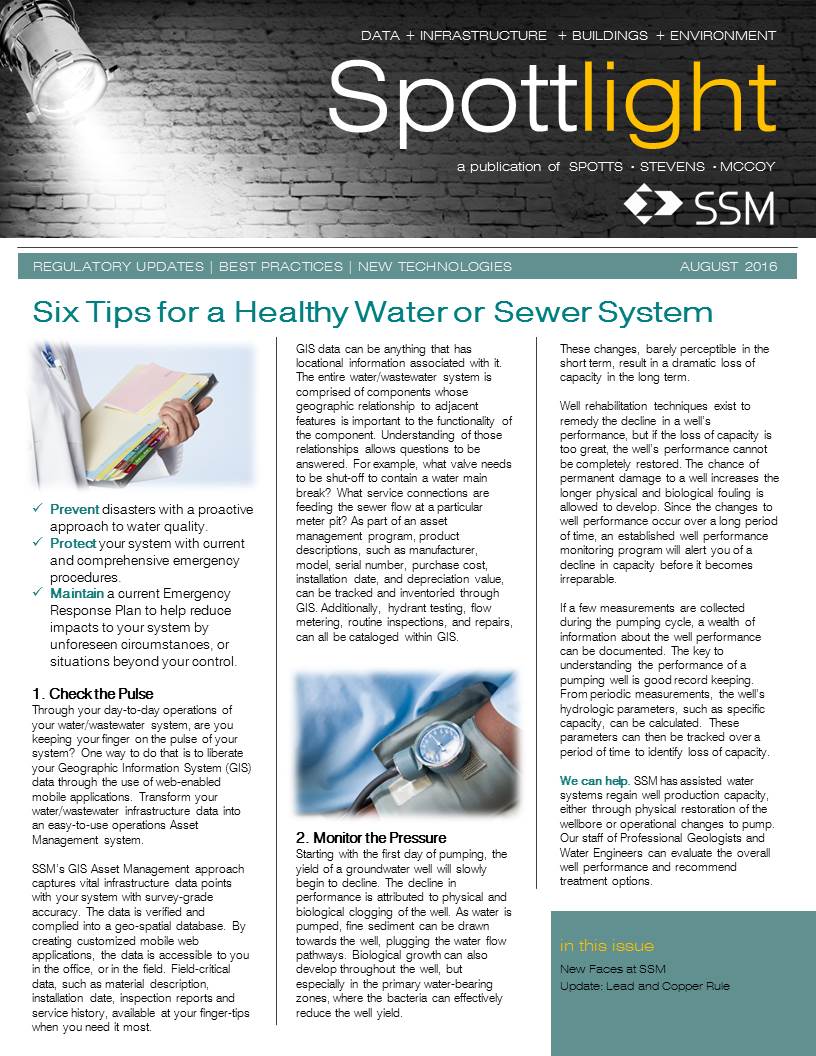Spottlight - August 2016
/Six Tips for a Healthy Water or Sewer System
1. Check the Pulse - Through your day-to-day operations of your water/wastewater system, are you keeping your finger on the pulse of your system? One way to do that is to liberate your Geographic Information System (GIS) data through the use of web-enabled mobile applications. Transform your water/wastewater infrastructure data into an easy-to-use operations Asset Management system.
2. Monitor the Pressure - Starting with the first day of pumping, the yield of a groundwater well will slowly begin to decline. The decline in performance is attributed to physical and biological clogging of the well. As water is pumped, fine sediment can be drawn towards the well, plugging the water flow pathways. Biological growth can also develop throughout the well, but especially in the primary water-bearing zones, where the bacteria can effectively reduce the well yield.
3. Protect your Immune System - In the event of an emergency that could impact treatment plant operations, immediate action is often critical in preventing or minimizing the incident. Boost your immunity from disaster by developing a comprehensive emergency response plan (ERP) as required by DEP. Possible emergency situations include a distribution system line break, power outages, drought conditions, disinfection system failure, contamination of supply, pump failure, and prolonged outage.
4. Prevention is the Best Protection - The first step towards prevention is to develop a Source Water Protection Plan. To maintain its usefulness, a Source Water Protection Plan should be updated every five years.
5. Check your Footing - In certain parts of Berks County, the ground can fall out from beneath your feet. What would you do if your utility lines were threatened by a sinkhole? SSM personnel have assisted municipalities, insurance companies, and legal defense teams in settlement instances involving sinkhole and non-sinkhole related damage claims. By observing, evaluating and documenting site specific details, we have often been successful at determining the causes leading to ground failures. Determining these details and causes have often been beneficial to our clientele whereby at times limiting their liability or determining their involvement with remediating sites and damaged infrastructures.
6. Have a Vision - Accurate knowledge of your system asset and infrastructural component locations in your water/wastewater system plays a vital role in healthy operations. Key operational decisions require precise geographic information. Relying on an outdated or incomplete system map will lead to wasted time and potentially costly mistakes. A comprehensive system map will provide the means to effective management. Just as our eyes are the window to the world, your system map is your view to the system as a whole. 20/20 vision of your system requires accurate locational data. Armed with up-to-date and comprehensive infrastructure data, the system can be run with greater efficiency and operational awareness.


